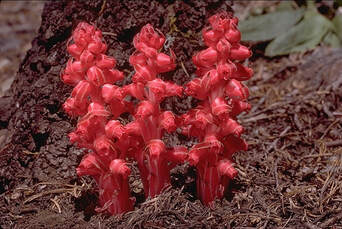|
5/19/2020 2 Comments Parasites in the Park: Snow Plant Snow Plant (Sarcodes sanguinea). Photo Credit: US Forest Service Snow Plant (Sarcodes sanguinea). Photo Credit: US Forest Service When the snow begins to melt in the Galena forest, it’s met with the contrast of a bright red pillar poking through, announcing spring. This plant contains no green foliage, causing the hiker passing by to wonder how it photosynthesizes. The secret is, it doesn’t! The Snow Plant (Sarcodes sanguinea) gets nutrients through other plants by way of the mycorrhizal (pronounced “my-ko-RY-zoll”) fungal networks of conifer trees. Pine trees, along with many other plants, develop a symbiotic relationship with fungi in their roots; the mycelial strands of the fungi extend beyond the roots and bring water and nutrients to the conifer, as well as connecting several trees together in a big underground network. The Snow Plant takes advantage of this network by parasitizing the mycorrhizae and taking some of the nutrients. Ultimately a parasite of conifers, you’ll start to notice that Snow Plants grow under or very close to conifers. Through this process, the Snow Plant doesn’t need to have any green foliage and can focus on reproduction and growth. Parasites are a natural part of an ecosystem and are more common than you think. Just like everything else, they play a role and are important for other organisms. Because Snow Plant is one of the first things to bloom in spring, they are an important food source for pollinators. Learn more here: US Forest Service - Snow Plant National Forests - Snow Plant Botanical Society of America - Snow Plant
2 Comments
Leave a Reply. |
AuthorThis blog is managed by the staff and volunteers of Galena Creek Visitor Center. We write about parts of the natural world that we find fascinating and want to teach others about, as well as keeping you updated on the Visitor Center and park. If you want to learn more, please sign up for our monthly newsletter, where we share upcoming events, updates on the ecology of the park, and highlights from each month. Archives
October 2021
Categories |
 RSS Feed
RSS Feed
